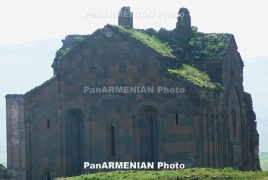 Ghost of cultureArmenian, Greek, Assyrian and Jewish heritage of Ottoman Empire In the framework of a cultural heritage inventory project, the Hrant Dink Foundation carried out a research on Armenian, Greek, Assyrian and Jewish churches, synagogues, monasteries, schools, hospitals and cemeteries in Turkey. PanARMENIAN.Net - During the research that lasted for about 2,5 years, 10,000 constructions were registered, of which 4,600 were Armenian, 4,100 were Greek, 650 were Assyrian and 300 were Jewish. The Foundation created an interactive map of these buildings available at Turkiyekulturvarliklari.com website. The project was implemented by Vahakn Keşişyan (Research coordinator, 2015, Armenian inventory, Armenian sources), Nora Mildanoğlu (Project coordinator, 2014), Merve Kurt (Project coordinator, 2015), researchers Zakarya Mildanoğlu, Mustafa Batman, Ezgi Berk, Tuna Başibek, Şahika Karatepe, Alexandros Kampouris, Zeynep Oğuz and and photographer Norayr Olgar. “People of different nationalities have lived on the land for centuries. However, only Muslim institutions have the authority to provide official information about the country’s cultural heritage. When you want to conduct a study, you can’t find any data in the archives, specifically regarding Armenian and Greek cultural heritage,” Kurt said, pointing out that this is the first project revealing the cultural heritage of the Anatolian non-Muslims. “We reviewed the primary and secondary sources. During the first year, we focused on the Armenian culture; and we focused on the heritage of Greeks, Jews and Syriacs during the second year. Church books were the most useful sources. We worked on the Ottoman Archives of the Prime Minister’s Office and added every church or school mentioned in the sources to the inventory.” Dwelling on the obstacles the specialists came across during the research, Kurt said, “For Greek sources, we went to Centre for Asia Minor Studies in Greece and for Syriac sources, we went to Sweden. We got a lot of data from there. Names of the places were the hardest part. We worked in accordance with the current provincial borders, while conducting another study on the old provincial borders in the archives. Comparing the old names with the new ones was difficult.” Nerkin Feneseh Armenian church Besides listing the construction that stand, the researchers registered almost destroyed and damaged buildings, as well as those which have been turned into mosques or are being used as warehouses. The Cultural Heritage Map vividly shows how many schools, churches and ordinary constructions were built by Armenians in Turkey. If one learns that the territory was once home to more than 4000 Armenian institutions, he will ask ‘where are these people now?’ If there were a lot of schools and churches, it means that a lot of Armenians used to live here. This proves that Armenians were part of this land and that Genocide took place,” he added. In 1914 the number of churches in Western Armenia and the Ottoman Empire made 2549. According to the data UNESCO provided in 1974, 913 buildings stood after 1923, of which 464 disappeared, 252 became ruins and 197 need restoration. According to research coordinator Vahakn Keşişyan, during the first stage, the researchers formed the inventory by determining the main sources: the list of Armenian churches and monasteries that was prepared between 1912 and 1913 by the Armenian Patriarchate of Istanbul. Raymond Kevorkian and Paul Paboudjian’s extensive work on Ottoman Armenians; archives of Agos Weekly Newspaper; and postcards from the Calumeno collection, the world’s largest Ottoman postcard collection belonging to Orlando Carlo Calumeno. The postcards were printed between 1895 and 1914, and reveal the multicultural structure of the Ottoman Empire and daily lives of Armenians in Istanbul and Anatolia. The postcards are ornamented with the pictures of Armenian neighborhoods, churches, monasteries, schools, orphanages and hospitals. “We started from those sources and then reviewed the others to understand what we lack. It was a hard job,” Keşişyan said. In addition to the cultural heritage of the 4 societies that we worked on, we found structures belonging to Georgians, Bulgarians and Levantines. However, we couldn’t add them to the inventory, since they are not in the scope of the project. But we have the data.” Researcher Aleksandros Kamburis said they used three main sources to complete the study on the Greek structures. “We got most of the data from the Patriarchate, the consulate and the Center for Asia Minor Studies in Athens. The biggest problem was disappearance of historical information. It’s impossible to find enough sources in Greek in Istanbul, as Greeks took most of the archives and records with them, when they were leaving. Fortunately, we could find them in Center for Asia Minor Studies,” he said. As for the study on Jewish public buildings, researcher Zeynep Oğuz said language was the main problem. “We had to use secondary sources, but sometimes sources in Turkish were more helpful. There are books by Naim Güleryüz which contain information about the structures that don’t exist anymore. We understood that Güleryüz’s work is the most extensive one. In fact, there are academic studies in English. Thanks to media like Agos and Bianet, we realized that sold houses and synagogues are not recorded in those studies. There are almost no retrospective sources,” he said. Greek church in Ozvatan The researchers are planning to continue their study, traveling to various regions of Turkey to find the constructions that have not been listed and about which no information is available. The Oscar-winning helmer who hopes to return to Armenia many, many times ICAE2018 proves a success Telling a story in a single image Chance to have another dream The other side of music How Indians turned into Armenian Gypsies Armenian Renaissance |